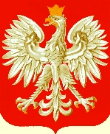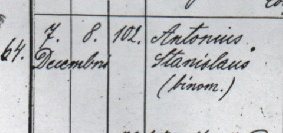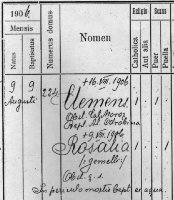Baptismal/Birth Record, Part 2
4. Nomen Baptisati (Name of Baptized)This is the name of the person born and baptized.
Sometimes a person was given two names. This was not a common custom, but can be seen occurring in the middle to late 19th Century. This was noted by the priest in Latin "binom" or "binominus". This is NOT two different children, but one and the same child.
Twins were noted by the term "gemelli" if they were two boys or one boy and one girl. The term "gemellae" was used if both were girls. Usually, each of the twins would have a godfather and godmother. (Sometimes, even more than one of each!)
Next to the name you may find a drawn cross. This means that the newborn died shortly after birth. It may be the same day or even weeks later. The specific date can only be determined by studying the Death Records for the same village and parish. Sometimes, a date was added right next to the cross signifying the date of death. Also, I have seen on some occasion that a conscientious priest returned to the baptismal/birth record to make such a notation for someone who had died much later in his/her life. Do not expect this to happen all too often, though. 5. Religio (Religion)
|
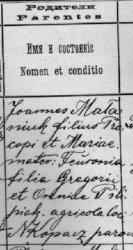 |
(Latin)
Joannes Małaniuk filius Procopi et Mariae.
Mater: Fewronia filia Gregorii et Oiniae Pilipiak. agricola loc. (Ukrainian first names) Ivan Malaniuk son of Prokopyi and Maria. Mother: Fevronia daughter of Hryhoryi and Oryna. local farmers. (Polish first names) Jan Małaniuk son of Prokop and Maria. Mother: Febronia daughter of Grzegorz and Orina. local farmers. |
Some Latin terms to watch out for are:
|
These last Latin terms above (filius and filia for son and daughter) would then require the genitive case of the following name, so you must be careful about noting the correct name. See more detail as to grammar and its effect on the language, in particular on proper names in my section on languages.
For showing maiden names, you may find these various Latin terms:
| Anna de Majewska | de "of" |
| Anna de domo Majewska or Majewskich | de domo "of the house of" |
| Anna ex Majewski | ex "from" |
| Anna nata Majewska | nata "born (with the maiden name)" |
Pay particular attention to the names of the spouses. Remarriage was very popular in the event of a spouseís death. Reasons based on financial, social and religious well being vary for the individual. The surname listed for the woman may be her maiden name, the surname of her first husband, or the surname of her current husband. In turn, you must be careful of these names in the future. A woman may be referred to in future records of her childrenís and grandchildrenís births, marriages, and death records with her own maiden name, the first husbandís surname or current surname. A thorough study of all of the womanís ancestors, even of the entire village, is necessary in order to track this properly. Of course, as always, you must be aware of the possibility of priest error, or copy error when looking at the Bishopís Copies.
Profession is usually written in Latin.
9. Patrini
(Godparents)
Sometimes includes Conditio (Profession)
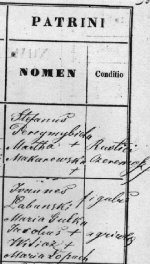
The priest wrote down the names of the Godparents, at least one Godfather and one Godmother. In some cases there may have been more than one.
One can check for connections between the family of the newborn and the Godparents. Of course, this can be difficult due to the lack of information on the Godparents provided. (As noted before, there is a great possibility that there were several people in the same village with the same exact name, even with the same age.) However, the Godparents can lead to clues and further research on your family history. You can also find out a little character information on someone if he/she appears as a Godparent for several children. Iíve personally seen a few people named as Godparent for dozens of newborns. One can assume that this person, hopefully a direct line ancestors, was well-liked throughout the village and parish!
In this example, the first group of grandparents are Stefanus Pereymybida and Martha Makarowska, both of whom were farmers from the village of Cheremoshnya/Czeremosznia. In the second group, this one child had four grandparents, who were Joannes Labunski, Maria Gulka, Karolus Wilicz and Maria Łopuch, who were all farmers, except for Joannes Labunski, who was a potter.
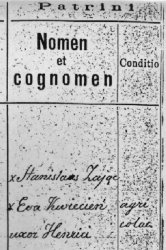
Note that the married Godmotherís maiden name is not usually given. Sometimes, her husband is listed with the Latin phrase "uxor", meaning "spouse of..."
Eva Kwiecien, uxor Henrici
Ewa Kwiecien, wife of Henryk (Pol.)
Eva Kwiecien, wife of Henrikh (Ukr.)
Often the priest or author of the record drew a "+" or Sign of the Cross next to the names of the godparents. This "+" or Sign of the Cross does NOT mean "deceased" as it does when it appears next to the name of the birth child. Roman Kałużniacki shared some important information to me and members of the Galicia_Poland_Ukraine listserv regarding this notation. He states that the priest was instructed to have the godparents sign the register. In the event the godparents were illiterate, they were to draw a "+" or Sign of the Cross. Understand that in the case of the Bishop's Copies, obviously the priest or scribe would simply write out the name or draw the "+". Finally, I should note that one does not frequently come across actual signatures in the original records.
On a personal note, I like to compare the religion of the Godparents to the religion of the parents to prove the good relations between the Roman Catholics and Greek Catholics on the village level. I also would like to add that there was in my village one cemetery where both Roman and Greek Catholics were buried together. As a distant relative (7th cousin) of mine I found in my ancestral village put it "they lived together, worked together, and were buried together".
Another use of tracking the Godparent is to confirm that the person was still living at that time. But again, remember that there could have been more than one person in the village with that name.
10. Bottom Line of Record
Also found within the baptismal/birth record is some other information that you may find interesting, if not helpful.
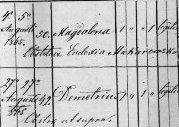
Obstetrix (Midwife)
sometimes abbreviated as "Obs."
Here the midwife is Eudoxia Makarowska
(Eudokia in Polish, Євдокія/Ievdokiia in
Ukrainian)
"Obstrx et supra": In stead of writing the same information over and over again, the priest may have written "ut supra" or "qui supra" which means that this information is repeated from the line above.

Name of Priest who performed the baptism. There is sometimes an additional statement written by the priest: "Ego to baptizo in nomine Patris, et Filii, et Spiritus Sancti" "I baptize you in the name of the Father, and of the Son, and of the Holy Ghost".
The priest may sign his name.
You may find these Latin terms:
In absteto: Another priest, either from a neighboring village or different Rite
(I have some Roman Catholic ancestors baptized by the Greek Catholic priest in
the village).
In this example, the priest was Stephanus Kuryś. "Bapt qui supra": In stead of writing the same information over and over again, the priest may have written "ut supra" or "qui supra" which means that this information is repeated from the line above.
|
www.halgal.com
Questions and Comments to Matthew
Bielawa |
